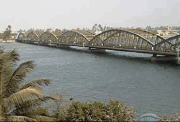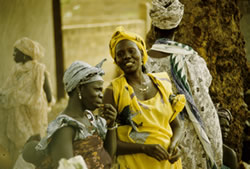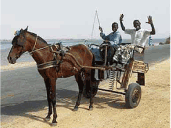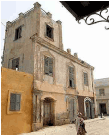ST. LOUIS SISTER CITIES PROGRAM
St. Louis-Saint-Louis, Senegal Sister Cities Committee
Who We Are:
Formed in the summer of 1994, Saint-Louis, Senegal, is St. Louis’ first African affiliation. Senegal is the westernmost country on the African continent. Over the years, educational, tourist, cultural, and business exchanges have developed to facilitate links between various institutions in both cities.
Linked to Dakar, Senegal’s capital city, by railway, Saint-Louis was once the capital of French West Africa. The city lies at the mouth of the Senegal River, and it is the transportation hub for the agricultural Senegal River valley. Saint-Louis offers a glimpse into the past, with its large old houses displaying wrought-iron railings and wooden balconies which still bear characteristics of the colonial period. The city hugs the mainland, an island, and also part of the Langue de Barbarie peninsula at the mouth of the Senegal River. Two smaller bridges link the island to the peninsula. Today, Saint-Louis is a fishing community, referred to as Guet N’Dor, which is home to 125,000 residents who come from a diverse ethnic group. The Wolof, Serer, Fulani, Diola, Manding, and Sarakole are common. The life expectancy is only 47 years of age.
The climate is tropical, with a wet season during the months of June through September, along with high humidiy. Precipitation decreases after October, and tornadoes occur at the beginning and the end of the rainy season. Average January temperatures range between 64-79 degrees Fahrenheit, and September finds temperatures anywhere between 75 and 90 degrees.
History:
Originally a French settlement established in 1659 as a fortified trading post, Saint-Louis is one of the oldest European-founded settlements in West Africa. It was the original capital city of both Senegal and Mauritania. In 1960, the former colony gained independence with French Sudan as the Mali Federation. This did not last, however, as Sudan later withdrew from the federation to become a separate republic.
The Portuguese were the first Europeans to reach the mouth of the Senegal River, and they began trade with the native Wolof people during the middle part of the 15th century.
Economy/Industry:
Major products include fish, ground nuts, timber, and maize. The major industries are agriculture, cement, fertilizer production, fishing, forestry, textiles, and mining.
Tourism:
Tours to the rooftop of the post office provide a scenic view of the bridge and city for tourists. Nearby is the governor’s palace, which was a fort during the 18th century. The cathedral from the year 1828 is the oldest church in Senegal along with a Muslim Cemetery are other points of interest. Finally, there is the Parc National de la Langue de Barbarie, which is home to a multitude of water birds, such as pink flamingos, white pelicans, herons, egrets, and ducks.
Committee Goals:
• Promote world peace, international understanding, cultural awareness, friendship, cooperation, tolerance, and respect for diversity
• Bring about the greatest amount of meaningful and mutually satisfying personal contact between the people of the two cities
• Provide a vehicle for exchange of ideas and information in the fields of education, culture, commerce, sports, conservation, science and technology, and municipal administration and development
Officer(s):
Renee Franklin, Co-Chair: [email protected]
Clayvon Wesley, Co-Chair: [email protected]
Committee Membership:
Annual Membership in the St. Louis-Saint-Louis, Senegal Sister Cities Committee:
Diaspora Ambassador Support Level: $300.00
Baobab Blessing Circle Supporter Level: $100.00
Individual Membership: $50.00



